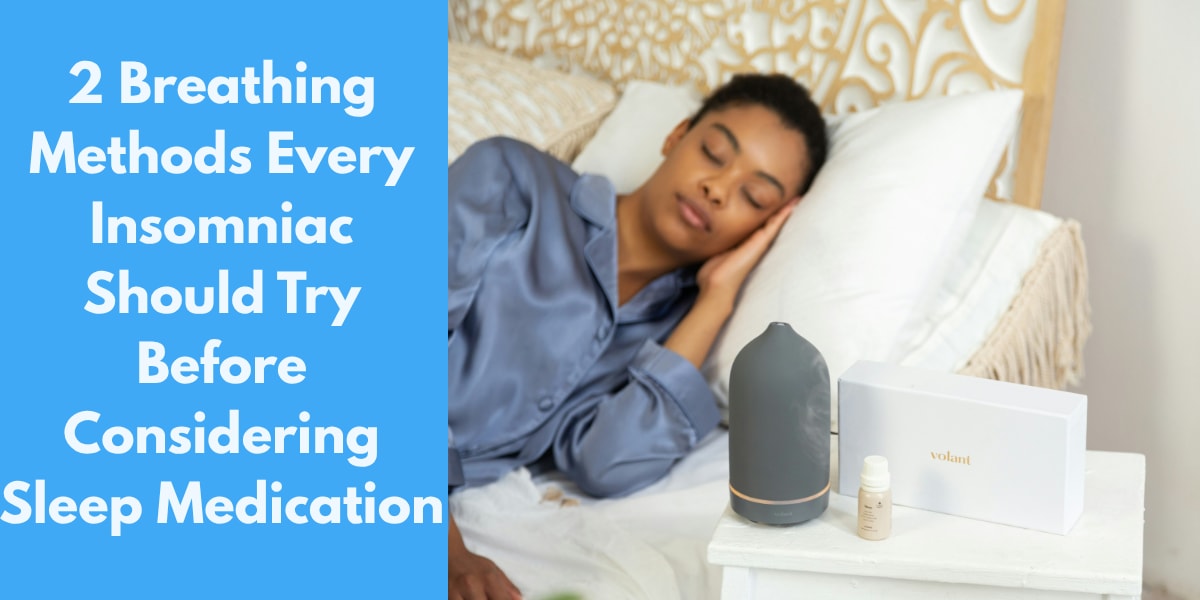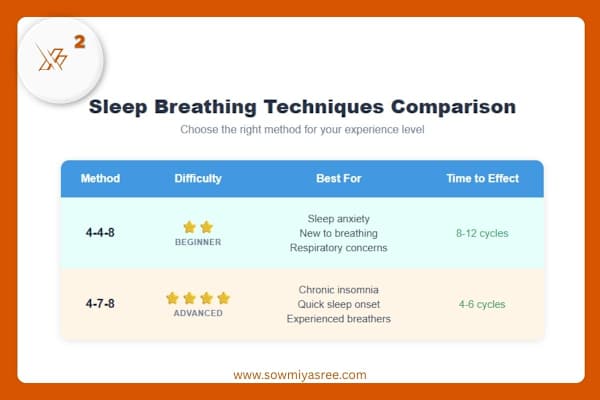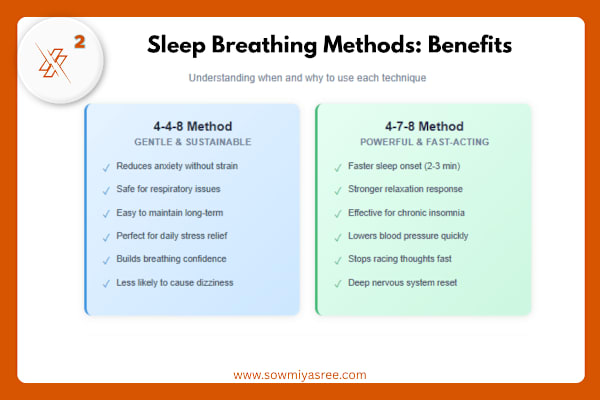⏰Estimated Reading Time: 4-5 minutes
📝Quick Summary
• Two proven breathing techniques help you fall asleep faster: 4-4-8 (beginner) and 4-7-8 (advanced)
• 4-4-8 breathing is gentler for newcomers - inhale 4, hold 4, exhale 8 counts
• 4-7-8 breathing creates stronger relaxation - inhale 4, hold 7, exhale 8 counts
• Both methods activate your parasympathetic nervous system for natural sleep induction
• Most people see results within 2-4 breathing cycles, with full effects in 8-12 rounds
• Start with 4-4-8 if you're new to breathing exercises or have anxiety
• Progress to 4-7-8 once comfortable for maximum sleep-inducing power
📋Table of Contents
- Introduction
- What Are These Sleep-Inducing Breathing Techniques?
- The 5-Step Transformation Process
- Expert Best Practices for Maximum Results
- Essential Sleep Tools and Breathing Apps
- Frequently Asked Questions
- Conclusion
-
Scientific Research and Studies on Breath and Sleeping
✨Introduction
Did you know that 68% of adults struggle with sleep disorders at least once per week — and most blame their racing minds? You're lying in bed, exhausted from the day, but your brain decides it's the perfect time to replay every awkward conversation from the past decade. Sound familiar?
This mental hyperactivity at bedtime isn't just annoying — it's sabotaging your health, productivity, and happiness. Poor sleep quality affects everything from your immune system to your decision-making skills. The good news? There are two ridiculously simple breathing exercises for sleep that don't require pills, gadgets, or expensive sleep therapy.
Here's what you'll discover in this post:
• The science behind why your brain won't shut up at night
• Two proven sleep breathing techniques: 4-4-8 (beginner-friendly) and 4-7-8 (advanced)
• How to choose which breathing method for insomnia suits your experience level
• Step-by-step instructions to master both sleep-inducing methods
• Expert tips to maximize your sleep improvement results
• Free tools and resources to track your progress
Ready to transform from restless night owl to peaceful sleeper? Let's dive into the breathing techniques that are changing bedtime routines worldwide.
😴What Are These Sleep-Inducing Breathing Techniques?
There are two powerful breathing patterns for sleep that can transform your bedtime routine and help with sleep anxiety:
The 4-4-8 Breathing Technique (Beginner-Friendly): Inhale for 4 counts, hold for 4 counts, exhale for 8 counts. This gentler approach to relaxation breathing is perfect for newcomers to breathing exercises for insomnia.
The 4-7-8 Sleep Breathing Method (Advanced): Inhale for 4 counts, hold for 7 counts, exhale for 8 counts. Popularized by Dr. Andrew Weil, this technique creates a more potent relaxation response and is considered one of the best breathing exercises for promoting a quick and restful sleep.
Both methods work the same way: when you exhale for twice as long as you inhale, you activate your parasympathetic nervous system — your body's "rest and digest" mode that counters the "fight or flight" response, keeping you wired with bedtime anxiety.
Which Breathing Technique for Sleep Should You Choose?
Start with 4-4-8 breathing if you:
• Are new to sleep breathing exercises
• Feel anxious about breath-holding techniques
• Have respiratory concerns or breathing difficulties
• Want to build confidence with relaxation methods first
Use 4-7-8 breathing when you:
• Can comfortably do 4-4-8 for several rounds
• Want maximum sleep-inducing power for chronic insomnia
• Have no breathing difficulties
• Are ready for advanced sleep improvement results
Research from Harvard Medical School shows that controlled breathing techniques for anxiety can reduce cortisol levels by up to 25% in just 10 minutes. The longer breath retention in 4-7-8 creates more carbon dioxide buildup, triggering an even stronger relaxation response and helping you fall asleep faster naturally.
The beauty of these sleep breathing methods lies in their simplicity — no special equipment, no complex positions, and no years of training required. Your breath becomes your remote control for your nervous system and your natural sleep aid.
Now let's explore exactly how to use these powerful tools to overcome insomnia and reclaim your nights.
5️⃣The 5-Step Transformation Process
Step 1: Create Your Sleep Sanctuary
Find your most comfortable position — whether that's in bed, on your couch, or in your favorite armchair. Dim the lights to create a calm and inviting atmosphere.
Why it's important: Physical comfort signals safety to your brain. When your body feels secure, your mind can finally let go of the day's worries. Research shows that environmental cues play a huge role in sleep quality — your brain needs the right signals to start winding down.
Step 2: Disconnect from Digital Stimulation
Put away all devices and resist that final phone check. Yes, even if you're expecting an important message — it can wait until morning.
Why it's important: Blue light from screens suppresses melatonin production for up to 3 hours. But it's not just the light — the mental stimulation from texts, emails, and social media keeps your brain in problem-solving mode when it should be entering rest mode.
Step 3: Take Three Foundation Breaths
Close your eyes gently and take three normal, natural breaths. Don't try to control them — just notice the rhythm your body naturally wants to follow.
Why it's important: These initial breaths create a bridge between your active day and restful night. Think of them as a "loading screen" for relaxation — giving your nervous system time to recognize that something different is about to happen.
Step 4: Choose Your Breathing Pattern
For Beginners - The 4-4-8 Method: Inhale slowly through your nose for 4 counts, hold your breath for 4 counts, then exhale completely through your mouth for 8 counts. Make that exhale long and gentle — like slowly deflating a balloon.
For Advanced - The 4-7-8 Method: Inhale slowly through your nose for 4 counts, hold your breath for 7 counts, then exhale completely through your mouth for 8 counts. The longer hold creates more powerful relaxation.
Pro tip: If you're unsure which to choose, start with 4-4-8 for your first week, then progress to 4-7-8 once comfortable.
Why it's important: Both ratios trigger your vagus nerve — the superhighway between your brain and your rest-and-digest system. The extended exhale is key because it tells your heart to slow down, your blood pressure to drop, and your mind to quiet. The 4-7-8 version creates stronger carbon dioxide buildup, leading to more profound relaxation.
Step 5: Repeat Until Your Mind Surrenders
Continue your chosen pattern for at least 4 complete cycles. Most beginners need 8-12 rounds of 4-4-8, while 4-6 rounds of 4-7-8 often suffice due to its increased potency. Don't count obsessively — let the rhythm become natural and soothing.
Why it's important: Repetition creates the neurological shift from "alert" to "sleepy." Each cycle deepens the relaxation response. With 4-4-8, the gentler approach allows for more cycles without strain. With 4-7-8, fewer cycles are needed because each round creates deeper physiological changes.
With practice, this entire process takes less than 5 minutes — but the results last all night long.
🎧 New Sleep Story Audio: Drift Off with Maya Tonight
Listen to my new 5-minute sleep audio featuring Maya + the calming 4-7-8 breath.
A gentle voice. A peaceful story. A perfect wind-down.
👉
🔄 Use it nightly for best results
💤 Ideal for: bedtime, post-screen detox, or even midday resets
🧘♀️ Voice: Calm, female narrator with sleep-inducing pace
💯Expert Best Practices for Maximum Results
Sleep specialists and breathing coaches have refined these techniques through years of practice. Here are their top recommendations:
• Master 4-4-8 before advancing to 4-7-8 — Build comfort and confidence with the gentler version first. Most people need 5-7 days of practice before progressing.
• Practice during the day first — Master the rhythm when you're not tired and stressed. This makes nighttime execution effortless for both techniques.
• Focus on the exhale, not perfect counting — If counting becomes stressful, just ensure your exhale is roughly twice as long as your inhale. The relaxation comes from the extended breathing out.
• Never strain with breath holding — If 7 counts feels too long in 4-7-8, stick with 4-4-8 until your lung capacity improves naturally.
• Create a pre-breathing routine — Dim lights, put on comfortable clothes, and eliminate distractions before you begin. Consistency amplifies results.
• Use both techniques strategically — 4-4-8 for daily stress management, 4-7-8 specifically for sleep and deep relaxation.
Breathing techniques work because they give anxious minds something concrete to focus on instead of spiraling thoughts. The key is finding the right intensity for each person.
These small adjustments can mean the difference between lying awake for hours and drifting off peacefully.
📲Essential Sleep Tools and Breathing Apps
While these breathing techniques for better sleep require no equipment, these tools can enhance your experience and help track sleep improvement:
Free Sleep Breathing Apps:
• Insight Timer — Offers guided sessions for both 4-4-8 and 4-7-8 breathing techniques for sleep
• 4-7-8 Breathing App — Simple timer with options for both breathing patterns for insomnia relief
• YouTube guided sessions — Search "4-4-8 vs 4-7-8 breathing for sleep" for comparison videos
Paid Sleep Improvement Options:
• Calm Premium ($70/year) — Professional sleep stories and breathing programs for anxiety relief
• Headspace Plus ($70/year) — Structured sleep courses with breathing foundations for better sleep quality
• Sleep tracking devices — Apple Watch or Fitbit can monitor your improved sleep patterns and breathing exercises results
Physical Tools for Better Sleep:
• Essential oil diffuser — Lavender or chamomile can enhance the relaxation response during breathing practice
• Blackout curtains — Create the ideal sleep environment for your breathing exercises
• Comfortable pillow support — Proper alignment makes breathing easier and more effective for sleep induction
The key is starting simple — master the basic breathing technique for insomnia before adding bells and whistles.
🙋🏻♂️Frequently Asked Questions About Sleep Breathing Techniques
How long does it take for 4-4-8 or 4-7-8 breathing to work for sleep?
Most people notice relaxation effects within 2-4 breathing cycles, but it typically takes 8-12 rounds of 4-4-8 breathing or 4-6 rounds of 4-7-8 breathing to feel sleepy. For individuals with chronic insomnia, consistent practice over 7-14 days yields the most significant sleep improvement results.
Can I do 4-7-8 breathing if I have anxiety or panic attacks?
Start with 4-4-8 breathing first if you have anxiety disorders. The longer breath hold in 4-7-8 can sometimes trigger anxiety in sensitive individuals. Once you're comfortable with the gentler technique, you can gradually progress to 4-7-8 breathing under relaxed conditions.
What's the difference between 4-4-8 and 4-7-8 breathing for sleep quality?
The 4-4-8 method is gentler and better for beginners, while 4-7-8 breathing creates a stronger physiological response due to increased carbon dioxide buildup. Studies suggest 4-7-8 breathing may help you fall asleep faster, but 4-4-8 is more sustainable for people with breathing difficulties or high anxiety.
Should I use these breathing exercises every night or only when I have insomnia?
For best results with sleep breathing techniques, practice your chosen method every night as part of your bedtime routine. Consistency helps retrain your nervous system's response to bedtime. You can also use these breathing methods for stress relief during the day.
Are there any side effects or risks with sleep breathing exercises?
These breathing techniques for sleep are generally safe for most people. However, if you feel dizzy, lightheaded, or anxious during practice, stop immediately and return to normal breathing. People with respiratory conditions, heart problems, or severe anxiety should consult a healthcare provider before starting any breathing exercises for insomnia.
🎯Conclusion: Choose Your Sleep Breathing Method Tonight
Your racing mind doesn't have to control your nights anymore. Both the 4-4-8 and 4-7-8 breathing techniques offer science-backed solutions for insomnia that work by hijacking your body's natural relaxation systems — you just need to choose the right starting point for your sleep improvement journey.
Remember the core principle: when you breathe out longer than you breathe in, you're literally switching your nervous system from "stressed" to "restful." The 4-4-8 method provides a gentle introduction to breathing exercises for sleep, while 4-7-8 breathing delivers maximum potency for experienced practitioners seeking faster sleep induction.
Tonight, give yourself the gift of peaceful sleep. Start with whichever breathing technique for better sleep feels comfortable — most people begin with 4-4-8 breathing and progress to 4-7-8 within a week. Find a comfortable position, put away your devices, and try just 4-8 rounds of your chosen sleep breathing pattern. Notice how your body responds to these natural sleep aids.
Most people feel the relaxation effects immediately, but the real magic happens with consistent practice of these breathing exercises for insomnia. Start tonight, and within a week, you'll wonder how you ever tried to overcome sleep problems without these powerful, natural sleep solutions.
🔬Scientific Research and Studies on Breath and Sleeping
British Heart Foundation. (2023, December 11). 3 breathing exercises to relieve stress. Retrieved from https://www.bhf.org.uk/informationsupport/heart-matters-magazine/wellbeing/breathing-exercises
Vierra, V. C., et al. (2022). Effects of sleep deprivation and 4-7-8 breathing control on heart rate variability, blood pressure, and blood glucose. _Physiological Reports, 10_(14), e15389. https://physoc.onlinelibrary.wiley.com/doi/pdf/10.14814/phy2.15389
Kim, J. H., Kim, J. H., & Kim, S. (2024). Acute effects of the 4-4-8 breathing technique on arterial stiffness in young men. Cardiology Journal https://journals.viamedica.pl/cardiology_journal/article/view/96299
Medical News Today. (2024, August 21). 4-7-8 breathing: How it works, benefits, and uses. Medical News Today https://www.medicalnewstoday.com/articles/324417
Medical News Today. (2024, August 21). 4-7-8 breathing: How it works, benefits, and uses. _Medical News Today_. https://www.medicalnewstoday.com/articles/324417
𓂃🖊Written by Sowmiya Sree | Breath Researcher & Author on a series of topics related to Breath
This article is thoroughly researched and fact-checked using peer-reviewed studies and trusted medical resources. Last updated: June 2025
Note: This article is for informational purposes only and does not constitute medical advice. Always consult your healthcare provider for medical concerns.
Sweet dreams await — one breath at a time.
Photo by Nubelson Fernandes on Unsplash


